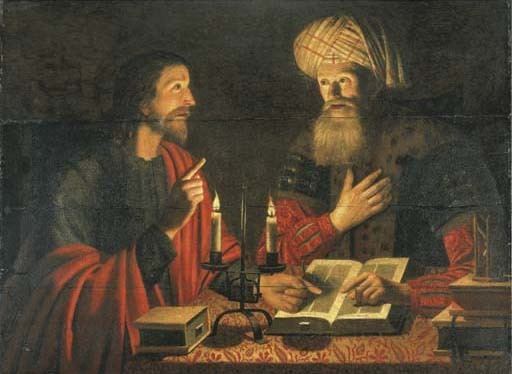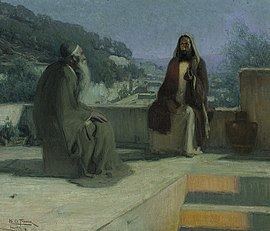Died Palestine | ||
 | ||
Similar Joseph of Arimathea, Pontius Pilate, Caiaphas, Gamaliel, Zacchaeus | ||
Nicodemus part 1 nigerian nollywood comedy movie
Nicodemus (/ˌnɪkəˈdiːməs/; Greek: Νικόδημος) is a Pharisee and a member of the Sanhedrin mentioned in three places in the Gospel of John:
Contents
- Nicodemus part 1 nigerian nollywood comedy movie
- Nicodemus part 2 nigerian nollywood comedy movie
- Nicodemus in Johns Gospel
- Veneration and liturgical commemoration
- Nicodemus in art
- Nicodemus in music
- In Protestant vs Catholic struggle
- United States
- Gallery
- References
An apocryphal work under his name—the Gospel of Nicodemus—was produced in the mid-4th century, and is mostly a reworking of the earlier Acts of Pilate, which recounts the harrowing of Hell.

Although there is no clear source of information about Nicodemus outside the Gospel of John, the Jewish Encyclopedia and many Biblical historians have speculated that he could be identical to Nicodemus ben Gurion, mentioned in the Talmud as a wealthy and popular holy man reputed to have had miraculous powers. Others point out that the biblical Nicodemus is likely an older man at the time of his conversation with Jesus, while Nicodemus ben Gurion was on the scene forty years later, at the time of the Jewish War.

Nicodemus part 2 nigerian nollywood comedy movie
Nicodemus in John's Gospel
As is the case with Lazarus, Nicodemus does not belong to the tradition of the Synoptic Gospels and is only mentioned by John, who devotes more than half of Chapter 3 of his gospel, a few verses of Chapter 7 and lastly mentions him in Chapter 19.
The first time Nicodemus is mentioned, he is identified as a Pharisee who comes to see Jesus "at night". John places this meeting shortly after the Cleansing of the Temple and links it to the signs which Jesus performed in Jerusalem during the Passover feast. "Rabbi, we know that you are a teacher who has come from God. For no one could perform the signs you are doing if God were not with him" (John 3:2).
Then follows a conversation with Nicodemus about the meaning of being "born again" or "born from above" (Greek: ἄνωθεν), and mention of seeing the "kingdom of God". Nicodemus explores the notion of being literally born again from one's mother's womb, but most theologians recognise that Nicodemus knew Jesus was not speaking of literal rebirth. Theologian Charles Ellicott wrote that "after the method of Rabbinic dialogue, [Nicodemus] presses the impossible meaning of the words in order to exclude it, and to draw forth the true meaning. 'You cannot mean that a man is to enter the second time into his mother’s womb, and be born. What is it, then, that you do mean?'"
Jesus expresses surprise, perhaps ironically, that "a teacher of Israel" does not understand the concept of spiritual rebirth. James F. Driscoll describes Nicodemus as a learned and intelligent believer, but somewhat timid and not easily initiated into the mysteries of the new faith.
In Chapter 7, Nicodemus advises his colleagues among "the chief priests and the Pharisees", to hear and investigate before making a judgment concerning Jesus. Their mocking response argues that no prophet comes from Galilee. Nonetheless, it is probable that he wielded a certain influence in the Sanhedrin.
Finally, when Jesus is buried, Nicodemus brought a mixture of myrrh and aloes—about 100 pounds (45 kg)—for embalming Jesus' body according to Jewish custom.[John 19:39] Nicodemus must have been a man of means; in his book Jesus of Nazareth: Holy Week, Pope Benedict XVI observes that, "The quantity of the balm is extraordinary and exceeds all normal proportions. This is a royal burial."
Veneration and liturgical commemoration
Nicodemus is venerated as a saint in the various Eastern Churches and in the Roman Catholic Church. The Eastern Orthodox and Byzantine Catholic churches commemorate Nicodemus on the Sunday of the Myrrhbearers, celebrated on the Third Sunday of Pascha (i.e., the second Sunday after Easter) as well as August 2, the date when tradition holds that his relics were found, along with those of Stephen the Protomartyr, Gamaliel, and Abibas (Gamaliel's second son). The traditional Roman Catholic liturgical calendar lists the same feast of the finding of their relics on the following day, August 3.
In the current Roman Martyrology of the Catholic Church, Nicodemus is commemorated along with Saint Joseph of Arimathea on August 31. The Franciscan Order erected a church under the patronage of Saints Nicodemus and Joseph of Arimathea in Ramla.
Nicodemus in art
Nicodemus figures prominently in medieval depictions of the Deposition in which he and Joseph of Arimathea are shown removing the dead Christ from the cross, often with the aid of a ladder.
Like Joseph, Nicodemus became the object of various pious legends during the Middle Ages, particularly in connection with monumental crosses. He was reputed to have carved both the Holy Face of Lucca and the Batlló Crucifix, receiving angelic assistance with the face in particular and thus rendering the works instances of acheiropoieta.
Both of these sculptures date from at least a millennium after Nicodemus' life, but the ascriptions attest to the contemporary interest in Nicodemus as a character in medieval Europe.
Nicodemus in music
In the Lutheran prescribed readings of the 18th century, the gospel text of the meeting of Jesus and Nicodemus at night was assigned to Trinity Sunday. Johann Sebastian Bach composed several cantatas for the occasion, of which O heilges Geist- und Wasserbad, BWV 165, composed in 1715, stays close to the gospel based on a libretto by the court poet in Weimar, Salomo Franck.
Ernst Pepping composed in 1937 an Evangelienmotette (motet on gospel text) Jesus und Nikodemus.
In popular music, Nicodemus' name was figuratively used in Henry Clay Work's 1864-written Civil-War-Aera piece "Wake Nicodemus", which at that time was popular in minstrel shows. In 1978 Tim Curry covered the song on his debut album Read My Lips (Tim Curry album).
In Protestant vs. Catholic struggle
During the struggle between Protestants and Catholics in Europe, from the 16th Century to the 18th, a person belonging to a Church different from the locally dominant one often risked severe punishment – in many cases a literal life danger. At that time, there developed the use of "Nicodemite", usually a term of disparagement referring to a person who is suspected of public misrepresentation of their actual religious beliefs by exhibiting false appearance and concealing true beliefs. The term was apparently introduced by John Calvin in his 1544 Excuse à messieurs les Nicodemites. To Calvin, who opposed all veneration of Saints, the fact of Nicodemus becoming a Catholic Saint in no way exonerated his "duplicity". The term was originally applied mainly to hidden Protestants in a Catholic environment – later used also in opposite cases.
United States
The discussion with Jesus is the source of several common expressions of contemporary American Christianity, specifically, the descriptive phrase "born again" used to describe salvation or baptism by some groups, and John 3:16, a commonly quoted verse used to describe God's plan of salvation.
Daniel Burke notes that, "To blacks after the Civil War, he was a model of rebirth as they sought to cast off their old identity as slaves". Rosamond Rodman asserts that freed slaves who moved to Nicodemus, Kansas, after the Civil War named their town after him. However, the National Park Service indicates that it was more likely based on a 1864 song Wake Nicodemus by Henry Clay Work used to promote settlement in the area.
In August 16, 1967, Martin Luther King Jr. invoked Nicodemus as a metaphor concerning the need for the United States to be "born again" in order to effectively address social and economic inequality. The speech was called "Where Do We Go From Here?," and delivered at the 11th Annual SCLC Convention in Atlanta, Georgia.
